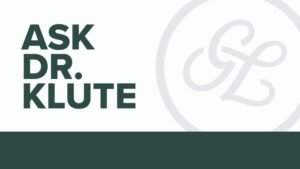A Parent’s Guide to Myopia Control
 As a parent, it is essential to understand the concept of myopia control and the available treatments to effectively manage your child’s visual health. Learn more from Dr. Klute below.
As a parent, it is essential to understand the concept of myopia control and the available treatments to effectively manage your child’s visual health. Learn more from Dr. Klute below.
Myopia, commonly known as nearsightedness, has become increasingly prevalent among children in recent years. This summary will provide you with valuable information regarding myopia control, the importance of early intervention, and the various treatment options available.
Understanding Myopia Control:
Myopia control refers to a range of interventions aimed at slowing down the progression of nearsightedness in children. The primary goal of myopia control is to prevent or reduce the extent of myopia development, which can potentially lead to more severe vision problems later in life. It is important to note that myopia control does not cure myopia but rather focuses on managing its progression.
Importance of Early Intervention:
Early intervention is crucial when it comes to myopia control. Studies have shown that myopia tends to progress rapidly during childhood and adolescence, increasing the risk of associated complications such as retinal detachment, cataracts, and glaucoma. By implementing myopia control measures at an early stage, parents can help slow down the progression of myopia and mitigate potential risks to their child’s eye health.
Myopia Control Treatments:
There are several effective treatments available for myopia control in children. These include:
- Orthokeratology (Ortho-K): This treatment involves the use of specially designed rigid contact lenses that are worn overnight. These lenses gently reshape the cornea, temporarily correcting myopia and reducing its progression. At Good Life Eyecare, we use a lens called Paragon CRT, which is one of the most popular overnight lenses used for controlling myopia.
- Multifocal Contact Lenses: Multifocal lenses are soft contact lenses that offer different powers across the lens, allowing clear vision at varying distances. These lenses have shown promise in slowing down myopia progression. The FDA recently approved a lens called MiSight, a daily disposable lens that has excellent research and success in controlling myopic progression in children ages 8-12.
- Atropine Eye Drops: Atropine eye drops, when administered in low concentrations, have been found to effectively slow down myopia progression. They work by relaxing the eye’s focusing mechanism, thereby reducing eye elongation and subsequent myopia development.
Lifestyle Modifications:
In addition to the aforementioned treatments, certain lifestyle modifications can aid in myopia control. Encouraging outdoor activities and reducing screen time can help alleviate the risk of myopia progression. Spending time outdoors has been associated with a reduced incidence of myopia, potentially due to increased exposure to natural light and the relaxed focusing mechanism while looking at distant objects.
Consultation with Eye Care Professionals:
To determine the most suitable myopia control approach for your child, it is imperative to consult an eye care professional experienced in pediatric myopia management. They will conduct a comprehensive eye examination, assess your child’s visual health, and recommend an appropriate treatment plan tailored to your child’s specific needs.
Myopia control is a proactive approach aimed at managing the progression of nearsightedness in children. By understanding the importance of early intervention, exploring various treatment options, and implementing lifestyle modifications, parents can play an active role in preserving their child’s visual health. Consulting with an eye care professional is essential for accurate diagnosis, personalized treatment plans, and ongoing monitoring. By taking these steps, parents can provide their children with the best chance for healthy vision and reduce risks associated with myopia.
Schedule your child today to find out which treatment is best for them to slow down their nearsightedness!

